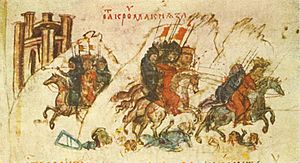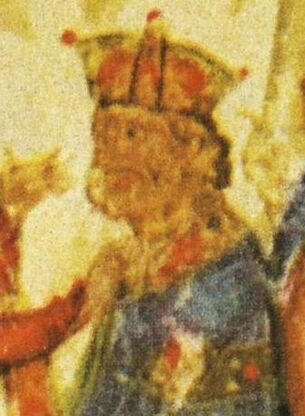Battle of Pliska facts for kids
Quick facts for kids Battle of Pliska |
|||||||
|---|---|---|---|---|---|---|---|
| Part of the Byzantine–Bulgarian Wars | |||||||
 The Battle of Pliska, depicted in the 12th century Manasses Chronicle. |
|||||||
|
|||||||
| Belligerents | |||||||
| First Bulgarian Empire | Byzantine Empire | ||||||
| Commanders and leaders | |||||||
| Strength | |||||||
| 15,000-18,000 | 22,000 60-70,000 (paper strength)/25-30,000 (actual strength) |
||||||
| Casualties and losses | |||||||
| Unknown | Most of the army | ||||||
The Battle of Pliska was a major fight between the Byzantine Empire and the First Bulgarian Empire. It happened on July 26, 811. The Byzantine army was led by Emperor Nicephorus I, and the Bulgarian army was led by Khan Krum.
The Byzantines had marched into Bulgaria and burned down the Bulgarian capital, Pliska. But the Bulgarians were smart. They blocked the mountain passes that the Byzantines needed to escape. The final battle took place in the Vărbitsa Pass in the Balkan Mountains. The Bulgarians used surprise attacks at night to trap the Byzantine army. They defeated almost the entire army, and Emperor Nicephorus I was killed. After the battle, Khan Krum reportedly used the skull of Nicephorus as a special cup.
This battle was one of the worst defeats in Byzantine history. It stopped Byzantine rulers from sending their armies north of the Balkans for over 150 years. This allowed the Bulgarians to grow stronger and expand their territory.
Contents
Why the Battle of Pliska Happened

When Nicephorus became the Byzantine Emperor in 802, he wanted to take back land that the Bulgarians controlled. In 807, he tried to attack but didn't get far. This attack made the Bulgarian leader, Khan Krum, decide to fight back. Krum wanted to expand Bulgaria to the south and west.
The next year, a Bulgarian army went into the Struma Valley. They defeated the Byzantines and took a lot of gold. Many Byzantine soldiers and commanders were killed. In 809, Krum himself attacked the city of Serdica and captured it. He killed all 6,000 soldiers defending the city.
Preparing for a Big Invasion
In 811, Emperor Nicephorus decided to end the conflict with Bulgaria once and for all. He gathered a huge army to conquer Bulgaria. This army included soldiers from different parts of the Byzantine Empire. It also had the Emperor's own special guards. Many important officials and rich people joined Nicephorus, including his son Stauracius. The whole army had about 22,000 soldiers.
The Attack on Pliska
The Byzantine army started their march in May. By July 10, they were near the Bulgarian border. Nicephorus tried to trick the Bulgarians with fake attacks. Khan Krum saw how big the Byzantine army was and offered to make peace. But Nicephorus was very proud and refused. He believed he could easily conquer all of Bulgaria.
Nicephorus led his army through the Balkan mountain passes towards the Bulgarian capital, Pliska. On July 20, he split his army into three groups. They faced little resistance. After three days, the Byzantines reached Pliska. The city was defended by 12,000 elite Bulgarian soldiers. The Byzantines defeated them and another Bulgarian army that quickly gathered. On July 23, the Byzantines entered the capital. They looted the city and the areas around it.
Khan Krum tried again to make peace. He told Nicephorus, "You have won. Take what you want and leave in peace." But Nicephorus was too confident. He thought he could conquer all of Bulgaria.
A historian named Michael the Syrian wrote about what Nicephorus's troops did. He said they looted and burned everything. They destroyed crops and killed animals. The Emperor took Krum's treasure for himself and didn't let his own soldiers take any.
The Battle in the Pass
While Nicephorus and his army were busy looting Pliska, Khan Krum was preparing a trap. He gathered all his people, including women and hired soldiers, to set up ambushes in the mountain passes.
Nicephorus had planned to march through another area before returning to his capital. But when he heard about Krum's preparations, he changed his mind. He decided to take the shortest way back. The Emperor didn't send scouts ahead to check the path. On July 25, the Byzantine army entered the Vărbitsa Pass.
Suddenly, Byzantine cavalry riders told Nicephorus that the road was blocked by wooden walls. Krum's forces were watching from the hills all around them. The Emperor became very worried. He told his companions, "Even if we had wings, we couldn't escape this danger." Before they could retreat, the Bulgarians blocked the entrance to the valley.
Nicephorus set up camp, even though his generals were worried. From the heights, the Bulgarian troops started banging their shields. This was to scare and upset the Byzantine soldiers. After three days, the Byzantine soldiers were very scared. That evening, the Bulgarians surrounded their trapped enemy. At dawn, the Bulgarians rushed down the hills. They attacked the panicked and confused Byzantines. The Emperor's special guards were attacked first. They fought for a short time but were defeated. When other Byzantine units saw this, they broke and ran.
As the Byzantines tried to escape south, they reached a muddy river that was hard to cross. Many soldiers, including those on horses, fell into the water and got stuck. More panicked soldiers arrived and trampled their own friends. The river became so full of dead bodies that the Bulgarians could easily cross over them to continue chasing the Byzantines.
Those Byzantines who made it across the river then faced tall wooden walls with ditches. These walls were built by the Bulgarians to block the escape routes. Many Byzantines tried to climb over the walls. Some were partly successful but got hurt or died trying. They also tried to burn the walls, but this didn't work and caused more deaths. Almost all the fleeing Byzantines were killed. Some died by swords, others drowned, and many were badly hurt at the walls.
What Happened After the Battle
Very few Byzantines survived this terrible defeat. Many important leaders were killed. The most famous person to die was Emperor Nicephorus himself. He reportedly died on the day of the battle. Nicephorus's son, Stauracius, was badly wounded in the neck but was carried to safety by his guards. He died six months later from his injuries.
As a tradition, Khan Krum reportedly had the Emperor's head placed on a spike. Then, he had the skull lined with silver and used it as a drinking cup.


